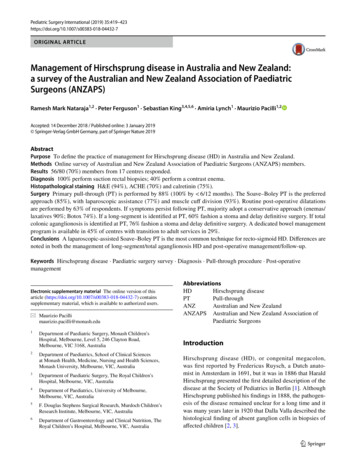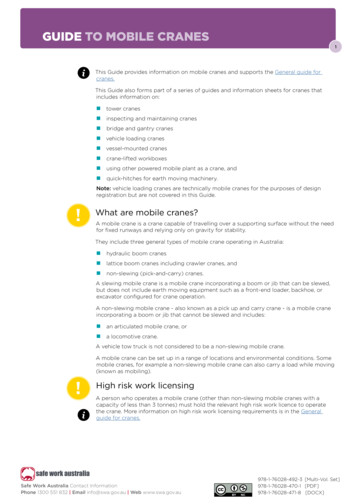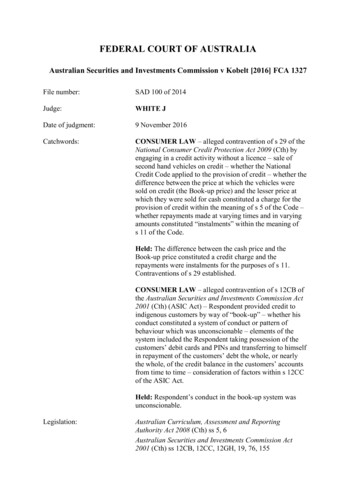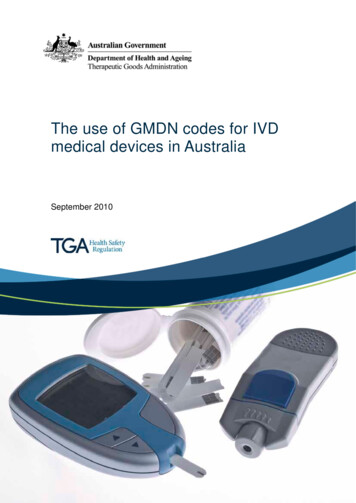
Transcription
Australia’sKitchenRevolutionReportMarch 2015
Australia’s Kitchen RevolutionMarch 2015ExecutiveSummaryJeremy NeedhamExecutive Director,Mitsubishi Electric AustraliaIn previous generations, the kitchen wasseparate from the main entertaining areas. Itwas utilitarian in purpose – used exclusively forcooking and closed off to guests. Now, however,the kitchen is the centre of the home for manyAustralian families, serving as a hub for not onlymeals but also conversations, special momentsand traditions.Mitsubishi Electric has been an integral partof Australian kitchens for more than 30 years,providing high-quality, innovative appliancesthat serve as fixtures in this important space.We pride ourselves on understanding theAustralian household and delivering productstailored to meet their needs. With this in mind,we engaged McCrindle Research to help usexplore the latest trends in home cooking andeating habits.We discovered that while the preferencesand needs of Australian families are diverseand constantly evolving, positive changes arealso brewing.While families are busier than ever, the researchsuggests they are also prioritising quality time aswell as quality ingredients and meals. With thehelp of new cooking and kitchen innovations,we may be returning to a simpler time – a timewhere new technology helped unite familiesinstead of isolate them.Australians are using the kitchen to set a betterfoundation for health, as well as stronger, moreconnected families.Mitsubishi Electric is looking forward to playingits part in helping Australian families createhealthier, happier starts – for another 30 yearsand beyond.
IntroductionOur food is more than just three squaremeals a day. It initiates connections, nurturesrelationships and inspires creativity. It impactshow we enjoy other’s company, our relationshipswith family and friends as well as our healthand longevity. By understanding more abouthow and what we eat, we can gain a deeperunderstanding of how we live.In exploring Australia’s latest cooking and eatinghabits, this report delves into three key issuesuncovered by the research:1. C ooking and the Modern Man: Traditionalgender roles are blurring thanks to men’sincreasing interest in preparing meals athome and entertaining guests. The resultis greater equality in the kitchen than inprevious generations.2. G eneration Y Leading the Home CookingRevolution: Generation Y is among thenation’s biggest cooking show fans, whichmay be impacting the generation’s evolvingcooking values and habits.3. D esire for Healthier, Family-Centric Homes:Australian families show a propensity fortraditional, family-centric values with a growingpreference for fresh, home cooked meals andthe desire to know more about their food.“ By understanding more abouthow and what we eat, we cangain a deeper understandingof how we live.”
Australia’s Kitchen RevolutionMarch 2015About Australia’sKitchen RevolutionCanvassing 2,000 household grocery buyersacross Australia, the survey reveals newinformation about how modern families arecooking and eating. The national online surveywas conducted between 21 and 27 August 2014,and this report highlights the key outcomes andanalysis of the results.The survey suggests change is stirring inAustralian kitchens, offering new insight into thefrequency with which families are cooking andentertaining at home, as well as their evolvingpriorities and values when it comes to filling uptheir grocery carts. It demonstrates a shift ineverything from how often Australians cook athome and who they cook for and why, to howoften they read ingredient labels, order takeawayand buy ready-made foods.Many factors influence our food purchasing andcooking decisions including price, quality, taste,health, family traditions and culture. Today,cooking is not just about food provision but alsosocial connection, nutrition and self-expression.
“ Today, cooking isnot just about foodprovision but socialconnection, nutritionand expression.”This is reflected in the report, which demonstratesa growing interest among Australians to learnabout the foods of foreign cultures. When askedthe cooking styles and cuisines about which theywere most interested in learning, Australiansindicated a variety of cultures and countries –from Chinese, Thai and Indian to Italian, Frenchand Mexican. This mirrors Australia’s increasinglymulticultural society as families continue toembrace the idea that diversity in food can enrichour day to day lives.The survey found significant differences infood habits between those who enjoy cookingshows and those who do not. Cooking showfans entertain more guests at social parties andholidays, focus on fresh ingredients and buymore fruits and vegetables and enjoy planningmeals ahead of time and cooking in bulk. Theyare also more innovative in trying not onlynew recipes and exploring different culinarycuisines but even in using new equipmentand appliances.The survey also uncovered another possibleinfluence on today’s cooking and eating habits– food and cooking shows. This includes TVshows that involve cooking demonstrations,competitions as well as cooking demonstrationson YouTube.This research explores how the popularity ofthis TV genre may be related to other changes incooking trends – including which demographicsare cooking and innovating the most.More than half of Australians (51%) reportwatching these shows regularly – at least once afortnight. Additionally, 2 in 5 main grocery buyerssay they either very much enjoy or extremelyenjoy watching them.what to place in our carts and how to prepareit. By understanding these relationships, we candevelop a deeper appreciation for the role thatfood plays in our daily lives.With this report, we evaluate how a variety offactors converge to influence how we decide
Australia’s Kitchen RevolutionMarch 2015A word from ourbrand ambassadorEd HalmagyiThe hustle and bustle of our day to day livesmakes many of us creatures of habit in thekitchen – cooking the same few dishes overand over again.What I found most interesting about thisresearch, however, was that some of today’smost popular TV programs – food and cookingshows – may be sparking a renewed interest incooking innovation and experimentation.It found that those who watch cooking showsat least once a fortnight are more likely to preferfresh ingredients, enjoy planning meals aheadof time and cook in bulk more than those whodo not watch cooking shows. They are also moreinnovative in trying new recipes and cuisinesand are more likely to use new equipmentand appliances.
How often do you watchcooking and food showson television or online?35%Once a weekor more12%Once amonthTo what extent doyou enjoy cookingan food shows?16%16%26%20%26%17%At least oncea fortnightLess than oncea month17%NeverWhen comparing Australians who love cookingshows with those who are passive towardsthem, there is a vast difference in what they buy,how they prepare meals and how much theyinnovate in the kitchen. While nearly everyonehas to cook, it looks like those who lovecooking shows do it with more passion, flair andenthusiasm. Whether you prefer a BBQ, casualget-together with friends or visits from family,it’s clear that there is a variety of influences ontoday’s cooking habits. This research suggeststhat Aussie families are becoming increasinglycommitted to exploring new ways of cookingthe food they love, broadening their tastes andputting their health at the forefront – whichis great news for the future of Australianhouseholds in years to come.ExtremelyenjoySomewhatenjoyVery muchenjoySlightlyenjoy15%Do notenjoy“ Some of today’s mostpopular TV programs –food and cookingshows, may be sparkinga renewed interest incooking innovation andexperimentation.”Ed HalmagyiChef and brand ambassador forMitsubishi Electric Australia
Australia’s Kitchen RevolutionMarch 2015
Cooking and theModern Man“ A successful dinnerparty could be anew type of statussymbol for men,”Jessica MillardMarketing & Communications Manager,Mitsubishi Electric AustraliaThe traditional gender roles of the kitchen are athing of the past, particularly when it comes tothe idea that it is solely the woman’s domain.Forty-two percent of men have increased thefrequency with which they cook at home overthe last two years. While women also reportedan increase in home cooking, the survey foundthat men now entertain guests as frequently aswomen (41%).Men are also taking time to prepare lunches athome more frequently and buying ready-madeconvenience meals less often. While they stillmay not be cooking more than women, theresearch suggests a positive shift in men’sattitude toward preparing meals. This may berelated to a wider change in the perception ofmen’s and women’s household roles, particularlyas more women maintain regular workplacecareers and more men choose to stay at hometo raise children.The research suggests that men now take pridein not only cooking and preparing meals but alsousing meals to entertain their friends. The surveyfound that men more commonly cook for socialdinner parties (35% compared to 32% for women).Women, on the other hand, are more likely to cookfor family gatherings and special celebrations.This may be a sign that men are striving to meetthe demands of the “modern man” – a man whois not only competent at work and at play, butalso in domestic duties.“Men enjoy being seen as competent and ableand this is no different for new householdrelated roles. Entertaining at home gives men anopportunity to demonstrate their ability in front ofpeers – a successful dinner party could be a newtype of status and success symbol for men,” saidJessica Millard, Marketing & CommunicationsManager, Mitsubishi Electric Australia.In addition to the potential impact of evolvinggender perceptions, the survey reveals that men’sgrowing interest in cooking may be related to therising popularity of food and cooking TV shows.
Australia’s Kitchen RevolutionMarch 2015Cooking and theModern Mancontinued“ Cooking shows area source of new ideas,making cooking athome more enjoyableand less challenging.”Jessica MillardMarketing & Communications Manager,Mitsubishi Electric AustraliaMen watch food and cooking shows nearly asfrequently as women (50% of men versus 52%of women), which may correlate with the changein cooking behaviour. Nearly half of the mensurveyed had tried a new recipe they learnedfrom a cooking show, suggesting that theshows are inspiring viewers to experimentin the kitchen.“Cooking shows are a source of new ideas,making cooking at home more enjoyable andless challenging. This is particularly true asthe trends in men’s behaviour mirror those ofwomen, who are also cooking at home andinnovating more often than in previous years,”said Millard.One significant difference between men andThe movement toward greater experimentationand innovation is further supported by resultsshowing that 66% of men said they have eitherregularly or sometimes cooked with new recipesin the last two years. Similarly, 62% of men saythey are more inclined to add new ingredients toold recipes, and 58% are more likely to try newways of cooking foods that are regularly bought.women are the values they prioritise whilegrocery shopping. While both rank buying ondiscount as an important value, women placestronger emphasis on buying fresh, local, organicfoods as well as based on brand and nutritionalvalue. Men, however, are more likely to buy onprice. This suggests women may be more healthconscious. Eighty-one percent of women citebuying fresh ingredients as very or extremelyimportant to them, compared to 68% of men.
42%66% of men report havingregularly or sometimescooked with new recipes inthe last two yearsof men have increasedthe frequency with whichthey cook at home in thelast two years32%41%of men have increasedthe frequency ofpreparing lunchesat home32% of men have decreasedthe frequency with whichthey buy ready-madeconvenience mealsCooking for social dinner partiesWomen28%35%Menmales and females entertainguests at least once per monthWatching cooking shows at least once a fortnight52%Women45%50%Menof men have tried new recipes from acooking or food show in the last two years
Australia’s Kitchen RevolutionMarch 2015
Generation Y:Leading the HomeCooking RevolutionGen Y, which for the purposes of this reportincludes respondents between the ages of20 and 34 years old, is leading the way whenit comes to home cooking in Australia. Thisgroup was the most likely to indicate they haveincreased the frequency of their home cookingin the past two years (54%), compared with theolder demographics.“ There are more influencersacting upon youngerconsumers than ever before.As our world becomesincreasingly connected,we may see even greaterdiversity in our cooking andeating habits in the future.”While older generations are more likely to cookfor family gatherings, members of Gen Y prefercooking for social dinner parties with friends.This may be because many Gen Ys have not yetstarted their own families. It may also be partof an effort to display newly acquired cookingability and domestication skills to their peers.“It’s easy to see why the idea of hosting dinner“The younger members of this group may seethe development of their cooking ability as away to showcase their maturity, particularlyas they enter new phases in life such as livingindependently or buying a home,” said Millard.In addition to cooking for themselves morefrequently, Gen Ys are also by far the mostfrequent entertainers. Fifty-four percent preparehome-cooked meals for guests at least onceper month compared to 36% of Gen X, 37%of Baby Boomers and 32% of Builders. Theyare also the most likely to have increased thefrequency in which they entertain at home overthe last two years.parties is enticing to the younger generations.They’re enjoying the process of cooking forothers – many for the first time – and sharingfood with friends,” said Millard.Another aspect of living independently ispurchasing grocery items. Interestingly,members of Gen Y are less likely to visit thegrocery store two or more times per week buttend to cook more for a time ahead, comparedwith older generations.While the research showed a greater affinity forbuying organic among Gen Ys compared to olderdemographics, younger consumers are morelikely to buy on price, placing less emphasis onbuying local products and fresh ingredients. Thissuggests that younger consumers may be lookingfor ways to stretch their dollar while shopping.
Australia’s Kitchen RevolutionMarch 2015Generation Y:Leading the HomeCooking Revolutioncontinued“ As the country’s mostfrequent watchers ofcooking shows, 61% ofGen Ys say they havetried new recipes afterseeing them on a show.”“Gen Y consumers are going through a period ofsignificant change. They’re may be relatively newto living on their own, just starting their own familyor focused on saving for major purchases, suchas a first home. It is understandable that theymight prioritise price more highly compared toolder, more established households,” said Millard.The group is also the most likely to innovatein the kitchen and explore new cuisines orflavours. Seventy-nine percent of Gen Yshave used new recipes in the last two years,compared with 71% of Gen X and Boomers and65% of Builders, and the group is the most likelyto look for innovations in cooking tools.As the millennial generation, Gen Ys areThere are more influencers acting upon youngermost influenced by others in their food andshopping behaviours than any other generation.This generation, linked up and logged on, ismore connected and engaged with the worldaround them than any previous generation ofgrocery buyers.consumers than ever before. As our worldbecomes increasingly connected, we may seeeven greater diversity in our cooking and eatinghabits in the future. The ability to learn from theworld’s top chefs and interact with people fromdifferent cultures will continue to encourage anew generation of ‘home celebrity chefs.Health organisations, professional chefs andfriends’ social media posts were identified asthe top three influencers in food purchasingdecisions and cooking habits.The survey also suggests, however, thatcooking shows may also directly influenceGen Y’s cooking behaviours. As the country’smost frequent watchers of cooking shows,61% of Gen Ys say they have tried new recipesafter seeing them on a show.Generation Y: 20-34 year oldsGeneration X: 35-49 year oldsBaby Boomers: 50-68 year oldsBuilders: 69 year olds
43%have increased thefrequency in which theyprepare lunch at home68%have explored newcuisines or flavoursin the last two years54%always cook inbulk ahead of time79%have cooked withnew recipes inthe last two years22%indicate buyingorganic is “extremely”or “very important”41%have looked forinnovations incooking tools31%of Gen Y have increased the frequencywith which they entertain at home54%have cookedmeals for guests46%have cooked for asocial dinner party
Australia’s Kitchen RevolutionMarch 2015
Healthier, MoreFamily-CentricHouseholds“ Consumers know moreabout their foods, aremore conscious of theirdecisions and have theintention to eat better,”Jessica MillardMarketing & Communications Manager,Mitsubishi Electric AustraliaAustralian families are increasingly prioritisinghealthy meals at home with their loved ones.More than half of shoppers are cooking at homemore often and eating out at restaurants lessoften, citing better health, caring for themselvesand their families, and eating more fresh andclean ingredients as the driving factors in theirdesire to do so.of consumers feel health organisations areat least somewhat influential in shaping theirshopping choices and cooking behaviour.When it comes to the grocery aisle, the researchdemonstrated shoppers are prioritising freshfood, above all else, superseding the valueplaced on both discount and price. In fact, 97%of shoppers said buying fresh is important tothem on some level.intention to eat better,” said Millard.Australians are also empowering themselvesin the grocery store, taking more time to readand understand labels and ingredient/additiveslists than ever before. Today’s shoppers are 5.7times more likely to have increased the time theyspend reading labels over the last two years.The people who influence Australians’ shoppingtrends are not necessarily their friends, popularsocial media personalities or even mainstreammedia celebrities. The research finds that healthorganisations are most important when it comesto influencing food behaviour. Fifty-three percent“All of this research suggests an overalldesire to be healthier across society. Whilethis desire may not always align with reality,consumers know more about their foods, aremore conscious of their decisions and have theIn addition to the desire for better health, Aussiefamilies may also be using home cooked mealsas a way to ensure quality family time. Fifty-onepercent of shoppers cook at home more nowand eat out less compared to previous years,and when cooking for guests, the survey foundthat family gatherings are the most commonoccasion (59%).Similarly, when asked what the single mostinfluential factor in activating their desire tocook, a number of Australians indicate thatit was their family.
Australia’s Kitchen RevolutionMarch 2015Healthier, MoreFamily-CentricHouseholdscontinued“The kitchen is the heart of the household. It iswhere everyone meets and intersects. Focusingon home-cooked meals with family reflects thedesire to create real and substantial interactionswith our loved ones – a way to bring the familytogether, if only for meals,” said Millard.The decision to cook at home more often mayalso be an economic one. Shoppers reportthat it is substantially cheaper than eating out.Although buying fresh food was cited as a topshopping value, consumers named price as themost important factor when deciding on whichproducts and ingredients to purchase. Three infour Australians indicated that price was eitherextremely or very important to them.“ Focusing on homecooked meals withfamily reflects the desireto create real andsubstantial interactionswith our loved ones.”“Whether it’s due to budget constraints, a risingcost of living or saving money, cost-cutting isfront of mind for main grocery buyers and a keydeterminant in moving towards preparing moremeals at home. Interestingly, the freshness ofingredients was close second as a top decisionmaking factor. This suggests that while we areinterested in making the process cheaper andeasier, we still want to feel like we are doing theright thing,” said Millard.Consumers are also using their time at home toinnovate and experiment. Three in four grocerybuyers (72%) have cooked with new recipesin the last two years, and two in three (66%)have added new ingredients to old recipes.Additionally, 63% have tried new ways ofcooking foods they regularly buy and 60%have explored new cuisines and flavours.
BuyingLocal66%72%of grocery buyershave tried new recipesBuying onDiscountadded newingredients toold recipesBuyingon PriceTOPSHOPPINGVALUESNutritionalValue60%have explorednew cuisinesand flavoursBuyingFresh40%have increasedthe time spentreading labels1 in 3have decreasedthe frequency withwhich they buyready-made meals44%have decreased thefrequency with which theybuy takeaway meals59%The averageshopping basketcomprises of 36%fresh fruit andvegetablessay family gatherings arethe most common occasionfor cooking at home
Australia’s Kitchen RevolutionMarch 2015Other KeyFindingsWhen comparing those whowatch cooking shows at leastonce a fortnight with thosewho don’t, cooking showenthusiasts are:5.3x4.5x2.4x2.1x1.7xmore likely to try new ways of cookingand recipes they’ve seen on television.more likely to cook for a religiousor ethnic holiday.more likely to entertain guests witha home-cooked meal at least onceper month.more likely to cook for a socialdinner party.more likely to try new ways of cookingand recipes they’ve seen on television.
The shopping baskets of those whowatch cooking shows contains:9%% of men who say these shopping valuesand priorities are extremely or very important:more fruits& vegetablesGrocery buyers in New South Walesand Victoria are:53%the most frequentwatchers ofcooking FreshDiscountNutritionPrice50% of Australians visit thegrocery store once a week.indicating buyingon discount asextremely or veryimportant to themVictorians tend to entertain themost compared to other states:45%60%% of woman who say these shopping valuesand priorities are extremely or very important:Queenslanders are bargain hunters:71%64%50%Those whose family ancestry is from SouthEast Asia are more frequent entertainers.% that entertain at least once a month:55%entertain atleast onceper monthSouth-East AsiaAncestryThose in capital cities are more likely to haveincreased the frequency of preparing lunchesat home:32%27%29%23%Capital citiesMajor citiesRegional citiesRemote areas41%All OtherAncestryWhat cuisine, cooking style, or dish arepeople most interested in learning to cook?
Australia’s Kitchen RevolutionMarch 2015AboutMcCrindleResearchAs Australia’s social researchers, McCrindletakes the pulse of the nation. Commissionedby governments, leading brands and someof Australia’s largest organisations, McCrindleis renowned for conducting world-classresearch and communicating the insightsin innovative ways.The McCrindle expertise is analysing findingsand effectively communicating insights andstrategies. Their skills are in designing anddeploying world-class social and marketresearch. Their goal is to advise organisationsto respond strategically to the trends andso remain ever-relevant in changing times,helping organisations, brands, and communitiesknow the times.www.mccrindle.com.auMethodologyThis new research was conducted via a nationalonline survey, between 21 and 27 August 2014.A total of 2,027 completed responses werecollected from main household grocery buyersacross 0-6869 ssurvey%National %of populationaged 18 ,1631%27%3128%13%100%GEN Z 2%GEN Y 28%GEN X 27%BOOMERS 29%BUILDERS %100%32%25%20%2%1%7%11%2%100%
AboutMitsubishiElectric AustraliaMitsubishi Electric Australia has provided highquality electrical and electronic products for thehome, business and industry in Australia for over40 years, actively working with local partnersin the development and delivery of equipmentfor satellite communications, railway rollingstock, and power transmission, distribution andswitchgear systems.Australian’s have experienced MitsubishiElectric products even if they did not know it.The stadium screens of Melbourne and SydneyCricket Grounds, Parramatta and TownsvilleStadiums all have had Diamond Vision screensshowing the action. Our factory automationproducts power Australia’s manufacturing andindustrial systems. Mitsubishi Electric suppliesequipment for many of the NSW passenger trainsincluding Tangara and OSCar trains.For over 30 years, MitsubishiElectric Australia has deliveredthe latest technologicaladvances in refrigeratorsand air conditioning.
For further information on this research, contact:Mitsubishi Electric Australia Pty. Ltd.348 Victoria Road, Rydalmere, NSW 2116Phone 02 9684 7777www.mitsubishielectric.com.auDesigns are representation for illustrative purposes only. 2015 Mitsubishi ElectricAustralia Pty. Ltd. ABN 58 001 215 792. All rights reserved. Printed in Australia.
Many factors influence our food purchasing and cooking decisions including price, quality, taste, health, family traditions and culture. Today, cooking is not just about food provision but also social connection, nutrition and self-expression. About Australia’s Kit











